Curved Mirrors - Complete Toolkit
Objectives
- To state the general rules of reflection of light off concave and convex mirror and to draw three sets of principal rays and their corresponding reflected rays for each mirror.
- To construct ray diagrams for any given object location in front of a concave or convex mirror in order to determine the image location, relative size and orientation of the image.
- To describe how images are formed by curved mirrors and to explain the distinction between real and virtual images.
- To describe how the characteristics of an image (location, orientation, size, and type) formed by a curved mirror are vary with object location.
- To use the mirror equation and the magnification ratio equation to solve word problems involving concave and convex mirrors.
Readings from The Physics Classroom Tutorial
- The Physics Classroom Tutorial, Reflection and the Ray Model of Light Chapter, Lesson 3
- The Physics Classroom Tutorial, Reflection and the Ray Model of Light Chapter, Lesson 4
Interactive Simulations
 The Physics Classroom: Optics Bench Interactive
The Physics Classroom: Optics Bench Interactive
Our new HTML5 Optics Bench interactive is a great way to explore the images formed by mirrors or lenses. You can adjust the focal length, the height of the object, and drag the object back & forth along the principal axis - then watch what happens to position, size, and orientation of the image. Values are displayed in real time. We’ve also included two Student Activities for exploring curved mirror image characteristics and mathematical relationships.
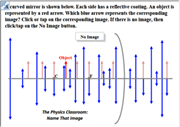 The Physics Classroom: Name That Image
The Physics Classroom: Name That Image
Want to challenge your students with an intense mental workout? Try our “Name That Image” skill-building tool. Learners are presented with an object location for a concave or convex mirror and must decide the location, orientation, and relative size of the corresponding image. Ray diagrams are drawn for each situation once the image is correctly located. Built-in score-keeping makes this a stimulating classroom activity.
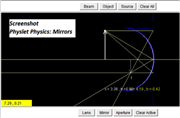 Physlet Physics: Mirrors
Physlet Physics: Mirrors
If you have the latest version of Java, you can now run Physlets for free on the ComPADRE website. The Physlet Mirrors collection could be a good candidate for a full-class discussion. Choose from seven guided explorations or eight problems that present more complex challenges. Each exploration is accompanied by a downloadable worksheet.
Video and Animations
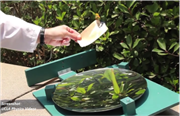 UCLA Physics Videos: Concave and Convex Mirrors
UCLA Physics Videos: Concave and Convex Mirrors
High School physics teacher James Lincoln brings us another well-produced short video: this one on image formation in concave and convex mirrors. In two minutes, he shows how a real image differs from a virtual image and discusses why mirrors (not lenses) are used in most telescopes. Great warm-up video for early stages of a unit on Geometric Optics.
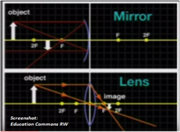 Education Commons RW: Mirrors and Optical Instruments
Education Commons RW: Mirrors and Optical Instruments
This professionally produced video takes a deeper dive into the differences between concave and convex mirrors and their use in optical instruments. It explains why mirrors, not lenses, are used in today’s large telescopes. The side-by-side drawings comparing ray diagrams for mirrors vs. lenses are especially helpful. The video explores the evolution of the telescope from the early Newtonian Reflecting models to today’s large computer-controlled multi-mirror systems.
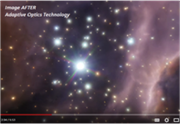 ESOcast: How a Giant Telescope Works
ESOcast: How a Giant Telescope Works
Fascinating video explores the technology behind the Very Large Telescope (VLT), located in the Atacama desert in Chile. A couple of decades ago, astronomical observation faced a hurdle: the mirrors used in large telescopes got so large they would deform under their own weight. The solution: lightweight thin mirrors and “Adaptive Optics”, a computer-controlled support system that corrects the real-time distortions produced by Earth’s atmosphere. Breathtaking images make this a very engaging supplementary resource.
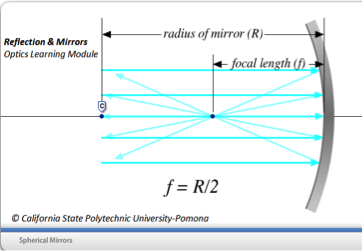 Cal Poly Pomona: Optics Learning Module
Cal Poly Pomona: Optics Learning Module
This set of interactive animations could be a great choice for students with disabilities or learners who are struggling with the content. It is paced slowly, with only one concept introduced per animation. It opens with plane mirrors and Law of Reflection, then works up to light reflection in convex and concave mirrors, finding focal length, and the Mirror Equation. Teachers: Three pages of the module are locked out, but most are accessible.
Labs and Investigations
- The Physics Classroom, The Laboratory, Exploring Curved Mirrors Lab
Students make observations of their image as they start close to a large concave mirror and slowly walk backwards; they repeat the process for a large convex mirror.
- The Physics Classroom, The Laboratory, Finding Smiley Lab
Students use a small concave mirror on an optics bench to project an image of a Smiley-faced light bulb onto a note card. Observations are made of the effect of varying object distance upon the image characteristics.
- The Physics Classroom, The Laboratory, Magnification Ratio Lab
Students use an optics bench and a concave mirror to determine the object locations that produce images that have magnifications of -1.0, -2.0, and -0.5.
Link: The Laboratory
Demonstration Ideas
 Green Power Science: Make A Parabolic Mirror
Green Power Science: Make A Parabolic Mirror
Want a good-size curved mirror, but don’t have the money in your lab budget? This short video shows you how to make one on the cheap. You re-purpose a used direct TV satellite dish, thoroughly sand it down, and apply peel-and-stick solar reflective film. The video host walks you through the process from start to finish, including links on obtaining supplies.
 Homemade Science: Concave Mirror Real Image Demo
Homemade Science: Concave Mirror Real Image Demo
Pennsylvania HS physics teacher Bruce Yeany features a device with a twist. At first, it looks like a simple light reflecting device using a mirror, light bulb, and battery. BUT WAIT! Remove the light bulb, press the switch, and you still see a lighted bulb in the mirror! Teachers: you know what’s going on – there’s a second light bulb installed upside down in the box directly underneath the upright bulb. When the hidden bulb lights up, its image is reflected and inverted by the concave mirror. Could be a great way to introduce a discrepant event at the beginning of a unit on Mirrors and Lenses, then segue into discussion of real and virtual images.
Minds On Physics Internet Modules:
The Minds On Physics Internet Modules are a collection of interactive questioning modules that target a student’s conceptual understanding. Each question is accompanied by detailed help that addresses the various components of the question.
- Reflection and Mirrors, Ass’t RM5 - Ray Tracing for Concave Mirrors
- Reflection and Mirrors, Ass’t RM6 - Image Characteristics – Concave Mirrors
- Reflection and Mirrors, Ass’t RM7 - Mathematics of Concave Mirrors
- Reflection and Mirrors, Ass’t RM8 - Ray Diagramming for Convex Mirrors
- Reflection and Mirrors, Ass’t RM9 - Image Characteristics – Convex Mirrors
- Reflection and Mirrors, Ass’t RM10 - Mathematics of Convex Mirrors
- Reflection and Mirrors, Ass’t RM11 – Real and Virtual Images
Concept Building Exercises:
- The Curriculum Corner, Reflection and Mirrors, Curved Mirrors and the Law of Reflection
- The Curriculum Corner, Reflection and Mirrors, Spherical Mirrors
- The Curriculum Corner, Reflection and Mirrors, Ray Diagrams for Concave Mirrors
- The Curriculum Corner, Reflection and Mirrors, Ray Diagrams for Convex Mirrors
- The Curriculum Corner, Reflection and Mirrors, Mathematics of Curved Mirrors
- The Curriculum Corner, Reflection and Mirrors, Object-Image Relations
Problem-Solving Exercises:
- The Calculator Pad, Ray Optics: Reflection and Mirrors, Problems #7 - #26
Link: http://www.physicsclassroom.com/calcpad/refln
Science Reasoning Activities:
- Science Reasoning Center, Reflection and Mirrors, Concave Mirrors
- Science Reasoning Center, Reflection and Mirrors, Object-Image Relationships
Link: http://www.physicsclassroom.com/reasoning/reflection
Real Life Connections:
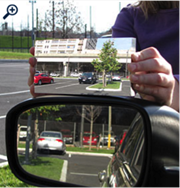 Driver’s Side Mirror with No Blind Spot
Driver’s Side Mirror with No Blind Spot
In 2012 a mathematician at Drexel University, Andrew Hicks, invented a curved side mirror for cars that greatly increases the field-of-view to eliminate blind spots (see photo above). His mirror has a field-of-view of about 45 degrees, compared with 14-17 degrees for flat driver’s side mirrors. Accidents caused by blind spots are an estimated 4% of automobile fatalities in the U.S. So why aren’t these mirrors being installed on all cars now? Because U.S. regulations call for flat mirrors on the driver’s side. Suggested class activity: students can do fact-finding to learn more about the flat-mirror regulation and construct arguments for or against changing the regulation.
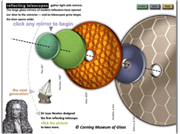 Corning Museum of Glass: Reflecting Telescopes Interactive
Corning Museum of Glass: Reflecting Telescopes Interactive
Beautifully produced interactive takes you on a journey through the evolution of the reflecting telescope – large concave glass mirrors that opened our door to the universe. Click to explore mirrors ranging from an early 20th century 60-inch telescope through the 200-inch telescope at Palomar, the Hubble Telescope, and the new generation of telescopes represented by the Subaru model. See how each innovation improved the quality of images and learn why we use mirrors for reflective telescopes (not lenses). Highly recommended for any phase of a unit on Geometric Optics.
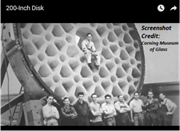 Corning Museum of Glass: The 200-Inch Disk
Corning Museum of Glass: The 200-Inch Disk
Sometimes students don’t appreciate that failure can be an inherent part of the design process. In 1929, Corning Glass Works accepted the job of making a 200-inch disk to use as the “Great Mirror” for the Hale Telescope on Mt. Palomar. The disk, made of special glass, was 26 inches thick and weighed 20 tons. But during the manufacture, things went wrong and the original disk was ruined. A second successful casting took place later that year, but you have to wonder: how much did the failed first attempt cost?
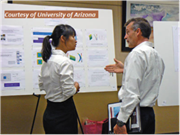 Laser Focus World: How to Begin a Career in Photonics
Laser Focus World: How to Begin a Career in Photonics
One good reason to teach a unit on Optics: career opportunities are attractive right now in the fields of optics and photonics. Scientists with advanced degrees in photonics can command starting salaries of $80,000 and up; job prospects are also solid for technicians with a bachelor’s degree. This article takes a candid look at the best optics/photonics programs in the U.S., Europe, and Asia.
Common Misconception:
- Images are Located on the Mirror Surface
A curved mirror image is located at a position in space where it seems that all the reflected light is coming from. Whether it is a real image or a virtual image, the location of the image is not on the mirror surface. Yet, it is a common belief to students that an image is location on the surface of the mirror. Like all misconceptions, this one needs to be directly confronted and addressed. Students must clearly recognize that their belief is inconsistent with the conclusions made in lab and the conclusions drawn from ray diagrams.
- Covering a Mirror Removes a Portion of the Image
Each part of a mirror serves to reflect light originating at the object and heading towards the mirror. Since each part of the mirror is involved in image formation, removing a portion of the mirror does not remove a portion of the image. That is, covering the top or the bottom of the mirror does not remove the top or the bottom of the visible image. Covering a portion of the mirror merely blocks some of the light and leads to the formation of a full image that is dimmer than its normal appearance.
Standards:
A. Next Generation Science Standards (NGSS)
Performance Expectations - Physical Science: Waves - Electromagnetic Radiation
- MS-PS4-2: Develop and use a model to describe that waves are reflected, absorbed, or transmitted through various materials. [Clarification Statement: Emphasis is on both light and mechanical waves. Examples of models could include drawings (ray diagrams), simulations, and written descriptions.
Disciplinary Core Ideas
- MS-PS4.B.1: When light shines on an object, it is reflected, absorbed, or transmitted through the object depending on the object’s material and the frequency of the light.
- MS-PS4.B.2: The path that light travels can be traced as straight lines except at surfaces between different transparent materials.
Crosscutting Concepts
High School: Structure and Function
- Investigating or designing new systems or structures requires a detailed examination of the properties of different materials, the structures of different components, and connections of components to reveal its function and/or solve a problem.
Middle School: Patterns
- Graphs, charts, diagrams, and images can be used to identify patterns in data.
Science and Engineering Practices
Practice #2: Developing and Using Models
- Develop and/or use a model to generate data to support explanations, analyze systems, or solve problems.
- Use a model to provide mechanistic accounts of phenomena.
Practice #5: Using Mathematics and Computational Thinking
- Use mathematical representations of phenomena to describe explanation
Practice #8: Obtaining, Evaluating, and Communicating Information: High School
- Communicate scientific ideas and information (e.g., about phenomena and/or the process of development and the design and performance of a proposed process or system) in multiple formats (including orally, graphically, textually, and mathematically).
- Critically read scientific literature adapted for classroom use to determine central ideas and obtain scientific/technical information.